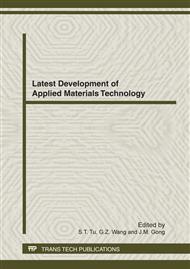p.36
p.40
p.46
p.51
p.56
p.64
p.68
p.75
p.82
Effect of Pulse Current on Tensile Deformation Behavior of IN718 Alloy
Abstract:
The pulse current was performed on the IN718 alloy during tensile test at room temperature and elevated temperature in the present study. The effect of pulse current on the deformation behavior of the alloy and the mechanisms were investigated. The results show that the deformation resistance decreases and the elongation increases significantly of IN718 alloy during tensile test at room temperature and 1073 K with the increase of pulse current. And the effect of pulse current on the strength and plasticity of the alloy increases as pulse current energy increases. The electroplastic effect of pulse current can promote the dislocation motion, and thus decrease the deformation resistance of the alloy during the tensile deformation. The pulse current reduces the starting temperature of recrystallization, promotes the recrystalllization nucleation, and thus makes it possible that the dynamic recrystallization would occur at lower temperature than that in the conventional temperature field. This is the main reason for the decrease of deformation resistance and the increase of plastic deformation ability of IN718 alloy under pulse current.
Info:
Periodical:
Pages:
56-63
Citation:
Online since:
April 2012
Authors:
Price:
Сopyright:
© 2012 Trans Tech Publications Ltd. All Rights Reserved
Share:
Citation:


